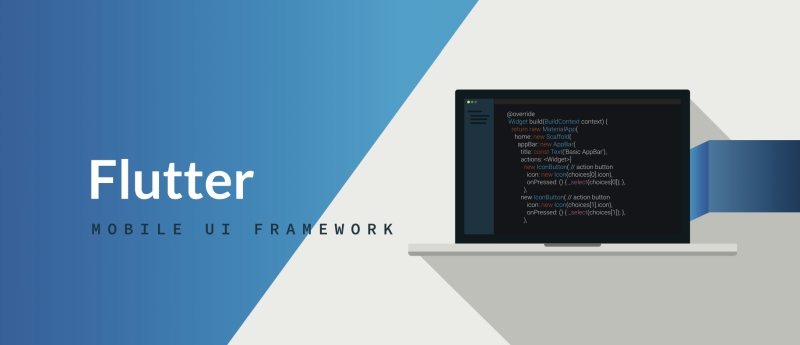The most popular open-source framework is none other than Flutter when it comes to mobile app development. The significance of mobile applications and websites has inclined everyone to learn mobile app development and web development, meanwhile considering their future career prospects. The emphasis on why everything one should know about Flutter infers upon its worthiness.
What is Flutter?
In the era of Internalization, this open-source framework is the best platform for reaching a global audience. It is supported and used by Google, trusted by well-known brands around the globe, and maintained by a community of developers.
Flutter is a masterpiece in mobile app development created by Google and released for the first time in May 2017. It allows developers to bring about web, desktop, and cross-platform applications that run on Android and iOS devices. By providing beautification, natively compilation, and multi-platform applications from a single codebase, it makes development faster and a convenient way rather than the rigid traditional methods by using Dart language programming.
Flutter is the only configuration with a mobile Software Development Kit(SDK) that effectively responds to the developers without using a JavaScript bridge. It enables Flutter to reach a level of performance that rivals its direct competitor React Native. It easily incorporates different platforms such as Android, IOS, Linux, Windows, MAC, and Google Fuchsia applications. One can easily access the website and watch the Flutter Tutorial to learn more and get a deep understanding of the framework.
This first-string programming tool for mobile app development consists of two main components-a UI framework and a Software Development Kit (SDK). The New SDK release, Flutter 3.7, continues to improve the framework by adding some great new features. The new features are;
- tools to better support internationalization
- enabling the developers to create custom menu bars
- cascading menus
- new debugging tools and much more

The Advantages and Disadvantages of Flutter
Flutter is an easily accessible and free open-source framework. It provides a variety of advantages to the developers, but it has certain disadvantages as well, up to some extent.
Advantages:
- Beyond the smartphones:
One can go beyond mobile app development on Flutter due to its new features; Flutter for Web and Flutter Desktop. Google’s technical preview of Flutter Web last year makes it possible to run Flutter applications in a browser without changing the source code. The technical preview event marks Flutter’s transition from a cross-platform mobile application framework to a full-fledged cross-platform development tool.
- The Developers Support:
Last year in terms of GitHub stars, Flutter surpassed React Native, which infers its significance and the embracing by the developers. Furthermore, the number of questions asked about Flutter on Stack exceeds the number of questions about React Native, which implies the focus of the developers is to learn more about Flutter.
- The single codebase framework:
The developers don’t have to worry about maintaining consistency across Web, iOS, and Android. The single codebase feature of the framework handles it, leading to hasty build time, saving of resources, and convenience in maintaining the code.
- Well, Documentation:
The documentation format is praiseful. It provides a well-organized, formatted way, making it easier to understand and beneficial for the developers.
- Hasty Development:
One of the main advantages of Flutter is its fast development time. Flutter’s unique architecture allows for a hot reload, which means the developer can observe the changes in the code without restarting the app and within no time. It saves a lot of time for the developers as they can make changes and observe the results immediately.
Disadvantages
- The complex language of Dart:
Flutter’s prerequisite language for coding is the Dart language. Though it is suitable for Flutter, the challenging nature of the language sometimes makes coding difficult for the developers. Moreover, Dart language is not a well-known programming language, and there is a need to learn the language to operate with Flutter.
- Nascent framework; emerging with the passage of its scope:
The open-source framework is still in a position to emerge as a full-fledged cross-platform tool. Though it has gained fame in cross-platform mobile app development, there are limited learning resources and a relatively small number of plugins and packages. Similarly, it also lacks third-party libraries, which enables some features for developers to have a significant impact on software development.
- The application size is large and weighty:
Flutter-developed applications are inherently larger than the applications created using native tools. Other competing frameworks can build comparable applications with convenient footprints. The requirements of including the framework’s engine and widget need the inclusion of more packages into applications. This drawback almost prohibits its use by the developers.
- Flutter-a prescriptive tool:
Flutter’s comprehensive nature and associated tools somewhat restrict the developers from assembling the project from many available frameworks and libraries. When Flutter’s workflow doesn’t fit with the existing practices of the developers, adopting the technology can be a significant challenge.
- Narrow Ecosystem:
Despite many improvements, Flutter’s relatively nascent and niche nature and language choice limit the ecosystem. For instance, existing JavaScript libraries that other frameworks can freely utilize can’t be imported into Flutter apps quite as easily.
How Does Flutter Work?
Flutter is an open-source UI software development kit created by Google, used for building natively compiled applications for mobile, web, and desktop from a single codebase. Here’s an overview of how Flutter works:
- Single Codebase: Flutter allows developers to write a single codebase in Dart programming language, which is then compiled into native code for different platforms. This means you can develop for iOS, Android, web, and desktop using the same code, significantly reducing development time and effort.
- Widgets: At the heart of Flutter are widgets, which are the basic building blocks of a Flutter app. Everything in a Flutter UI is a widget, from a simple text box to a complex animation. Widgets can be combined and customized to create complex layouts and designs. They also manage important aspects like state and context.
- Dart Language: Flutter uses Dart, a language developed by Google, optimized for building UIs and designed to be easy for developers from various backgrounds, particularly those familiar with object-oriented concepts.
- Rendering Engine: Flutter has its own high-performance rendering engine, built with C++ and known as Skia. This engine is responsible for rendering the UI built with Flutter’s widgets directly onto the canvas provided by the platform. This is key to why Flutter apps can run so smoothly and achieve consistent 60fps (frames per second) performance.
- Compilation: For mobile apps, the Dart code is compiled into native ARM code for both iOS and Android. This compilation of native code is what allows Flutter apps to achieve near-native performance.
- Hot Reload: One of Flutter’s most beloved features is hot reload, which allows developers to see the effects of their code changes almost instantly, without losing the current application state. This feature greatly speeds up the development process.
- Platform Channels: For accessing platform-specific services like camera, Bluetooth, and GPS, Flutter uses platform channels to communicate between its Dart codebase and the native platform code.
- Package and Plugin Ecosystem: Flutter has a growing ecosystem of pre-made packages and plugins that can be used to quickly add new functionality to an application, reducing the need to write everything from scratch.
Why ZEGOCLOUD API You Need for Flutter?
ZEGOCLOUD, established in 2015, is a global-leading cross-platform communication service provider. It facilitates organizations and developers to obtain real-time audio and video communication capabilities conveniently within no time by integrating a single SDK.
Up to now, ZEGOCLOUD has provided high-quality services to 200+ users in various countries and regions, gaining the satisfaction and credibility of several leading customers in social, gaming, live streaming, finance, education, medical, and intelligent hardware industries and fields.
ZEGO Express SDKs provide rich APIs for quickly building audio/video calling and live streaming capabilities into your applications based on ZEGO’s cloud live streaming SDK. With a powerful audio/video processing engine and a global real-time network, the platform facilitates high-quality and reliable cloud audio/video streaming services to businesses globally.
Key Features
The implausible features provided by ZEGOCLOUD are as under;
- Guarantees high audio/video pre-processing and conferencing
- IVR / Voice Recognition
- Network adaptation
- Cross-platform compatibility
- A Massive Software-Defined Network (MSDN) is a massive and orderly self-learning data network.
- Ready-to-use UI components or entire UI Kits to help cut deployment times
- Global support for diverse client devices and network environments
- Low-cost solution to bring high-end performance to your applications
- High availability with 99.99% uptime assurance
- Software Development Kits support nearly 20 programming languages
- Bounteous documentation to find what you need
- A latency of 79ms was achieved, with an average of just 300ms
- High standards of privacy and data security
- It is available for all major platforms, including Android, iOS, Mac, Windows, and Web.
Conclusion
If you are a Flutter developer, ZEGOCLOUD will be the best API/SDK provider you should know. Just Sign up for 10,000 free minutes to start your app-building with Flutter now.
Read more:
Let’s Build APP Together
Start building with real-time video, voice & chat SDK for apps today!










